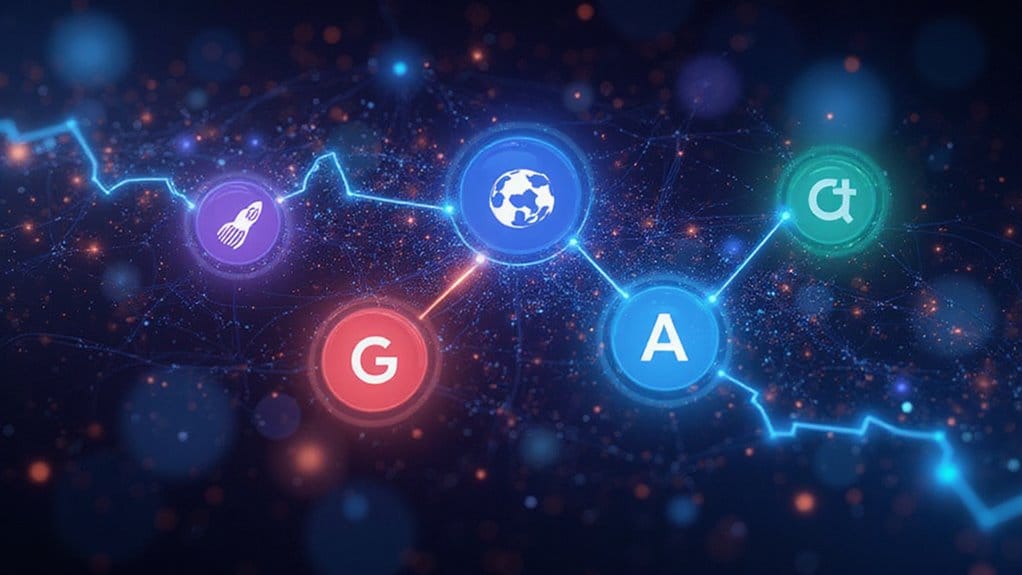Harnessing AI for deeper IT data insights is essential. It processes vast quantities of data, transforming it into clear visuals and patterns, which means no more squinting at spreadsheets. Want predictive analytics? AI can forecast trends, helping you dodge costly mistakes. Plus, it catches data errors—no more guessing games! Everyone can jump in, thanks to user-friendly interfaces. So, stop missing opportunities—give AI a go, and discover what you’ve been overlooking! There’s more to explore, trust me.

In today’s fast-paced world, IT professionals can’t afford to ignore the power of artificial intelligence (AI). Seriously, if you want to stay competitive, you need to harness AI for deeper data insights. Why? Because AI is like having a super-smart assistant that processes data faster and more accurately than any human could. Imagine the time you’ll save when AI whizzes through data cleaning and report generation, while you sit back and sip your coffee.
Let’s talk about data visualization and predictive analytics. AI tools take massive data sets and transform them into clear, visual insights. So, instead of drowning in spreadsheets, you get vibrant graphs that tell you exactly what’s happening. This isn’t just pretty; it’s necessary. You need to spot trends and patterns before your competitors do. AI-driven tools like Tableau GPT can create interactive dashboards, making data visualization accessible to all users. The rise of AI in business has revolutionized the way organizations interpret their data, enabling them to make informed decisions at unprecedented speeds.
AI transforms massive data sets into clear, vibrant visuals, making it essential to spot trends before your competitors do.
Ever heard of predictive analytics? It’s AI’s crystal ball, helping you forecast future trends based on historical data. If you’re not using this, you might as well be throwing darts in the dark.
Now, don’t think for a second that this is just for data scientists. With AI, even non-technical users can take a stab at data analysis. The interfaces are designed to be user-friendly. You just ask a question in plain language, and voilà! You receive insights without diving into complex jargon.
But wait, there’s more! AI doesn’t just simplify; it validates. It catches errors and inconsistencies in your data, ensuring what you see is what you get—accurate and reliable insights. This means your data-driven decisions won’t lead you down the wrong path, aligning with the need for quality data that is essential for successful analytics.
Frequently Asked Questions
How Does AI Improve Data Accuracy in IT Systems?
AI improves data accuracy in IT systems through machine learning and predictive analytics.
It detects errors, like duplicates or missing values, automatically—saving you from those tedious manual clean-ups. Imagine AI as your diligent assistant, working tirelessly to correct issues in real time.
By analyzing vast datasets, it reveals trends and patterns that might slip by unnoticed.
Don’t let poor data haunt your decisions; embrace AI and watch your data quality soar!
What Are the Costs Associated With Implementing AI for Data Insights?
Implementing AI for data insights isn’t cheap! Expect high implementation costs due to data acquisition, specialized hardware, and skilled talent.
Sure, the upfront investment can sting, but don’t forget about long-term savings—efficient processes mean less wasted time and resources.
So, weigh your options carefully. Consider cloud solutions for flexibility.
And remember, every penny spent now could save you dollars later. Don’t let costs scare you off; embrace the future!
Can AI Work With Existing IT Infrastructure?
Can AI work with existing IT infrastructure? Absolutely, but beware! AI integration requires infrastructure compatibility. First, assess your hardware—do you have the right GPUs? Next, check your software stacks; TensorFlow and PyTorch are your friends. Don’t forget network bandwidth; low-latency is key! Finally, guarantee your team is trained. So, roll up your sleeves and make those adjustments, or risk being left behind in the tech dust.
What Skills Are Needed to Manage AI in IT?
Managing AI in IT demands a cocktail of skills: first, embrace AI literacy—understand its basics or risk drowning in jargon!
Next, technical expertise is non-negotiable; without it, you’re flying blind.
Don’t ignore data governance; keep your data tidy and compliant, or face messy consequences.
Finally, master change management. Change is coming, folks! Adapt, lead, and maybe even crack a smile at the chaos.
Ready to plunge into?
How Is Data Privacy Maintained When Using AI?
Data privacy with AI? Oh, it’s a big deal!
To keep your data safe, use data encryption—think of it as a super-secret code. Follow privacy regulations like GDPR, or risk hefty fines.
Make certain that data is anonymized and processed securely. Remember, informed consent is key! So, always ask before collecting data.
Trust must be earned, and privacy shouldn’t be an afterthought. Keep it tight, keep it right!








